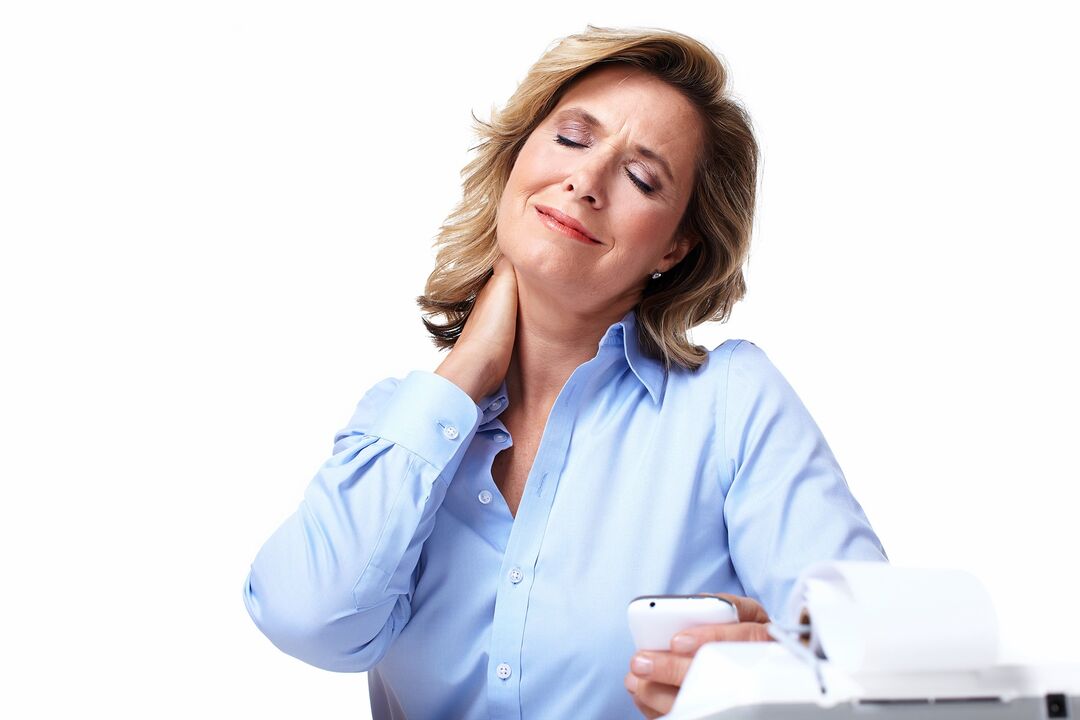Osteochondrosis is a disease that destroys the intervertebral discs and joints of the spine. Of all five parts of the spine, all of them can be affected by the disease, but the manifestations and symptoms of osteochondrosis of the cervical spine give people most of the problems. This is due to the large number of nerve fibers and endings, as well as the blood vessels that feed the brain, passing through the neck.

This area of the spine is the most mobile. It is thanks to the neck that a person has the ability to turn and tilt his head. The constant load reaching the cervical region contributes to degenerative changes in its structure and the development of osteochondrosis.
Who is affected by the disease
Most often, the disease develops and begins to manifest itself between the ages of twenty-five and thirty due to the long forced stay of a person in a static and uncomfortable position. It affects, first of all, employees, drivers, operators of various kinds of equipment. Often the disease manifests itself in athletes as a result of training or, conversely, with their abrupt cessation.

The main causes of osteochondrosis in the cervical and thoracic spine are poor posture, a sedentary lifestyle, heredity, an improperly organized workplace or an uncomfortable bed. Weight lifting also contributes to the appearance of this disease, since microtraumas are possible in this process, contributing to dystrophic changes in the cartilage and bone tissues of the spine.
Stages of development of osteochondrosis of the spine
- The intervertebral discs are just starting to collapse, losing moisture and elasticity. This process can take a long time. The stage is characterized by instability.
- It is characterized by the protrusion (bulge) of the discs. The intervertebral spaces are reduced due to the destruction of the fibrous ring of the disc and the decrease in its height. Pain can occur due to pinching of the nerve roots by the approaching vertebrae and protruding discs.
- There is a complete destruction of the fibrous ring and, as a result, the formation of intervertebral hernias. The spine is significantly deformed.
- This stage is the most difficult, as pain occurs with almost any movement. Bone growths appear, connect the vertebrae, limiting mobility. Such growths can cause disability.
Distinctive signs of cervical osteochondrosis
The blood vessels that feed the brain are mainly found in a person's neck, so many of the signs of the disease are associated with impaired blood circulation in the brain.

- So, here are the signs of osteochondrosis of the cervical spine, noting which one, you need to consult a doctor:
- intense and persistent pain in the neck and head, extending to the eyes and ears;
- pain in the arms, which worsens with any exertion;
- difficulty in movements of the fingers and hands, a violation of their sensitivity;
- muscle tension in the neck;
- when turning and tilting the head, the appearance of pain in the neck;
- the appearance of excruciating pain in the neck and neck;
- the occurrence of dizziness when turning the head (even before fainting), tinnitus;
- numbness of the tongue, blurred vision and hearing;
- pain in the heart, not cured by taking the appropriate medications;
- nausea, unstable blood pressure;
- sore throat, swallowing disorders;
- feeling short of breath.
Pathology symptoms
The manifestation of symptoms of osteochondrosis of the cervical spine can be associated with a malfunction of the following organs and systems in the patient's body:
- compression and rupture of the spinal cord in the spinal canal. Such symptoms are rare and can appear only in very severe cases;
- changes in the peripheral nervous system, the cause of which is the compression of the nerve roots located near the affected vertebrae;
- violation of blood supply to the brain.
When diagnosing this disease, the doctor pays attention to the presence of a number of symptoms. Their appearance depends on which part of the spinal column was caught by the disease.
Cardiac syndrome in osteochondrosis of the cervical spine
The signs of heart syndrome in osteochondrosis are similar to those of angina pectoris, this is due to irritation of the roots of the pectoralis major muscle or the phrenic nerve. The resulting pain can last up to several hours, and with sneezing, a sharp turn of the head, the cough becomes stronger.
Tachycardia and extrasystoles may appear, which do not disappear with the use of appropriate drugs, and the cardiogram does not show any abnormalities.
Syndromes of irritative reflexes
This group of syndromes is characterized by severe pain in the neck, aggravated by movement, coughing, turning the head and sneezing. It can radiate to the shoulder or chest.
radicular syndrome
This syndrome occurs when the cervical nerve is pinched. It is characterized by the spread of pain from the neck to the shoulder blades and from the forearms to the fingers. Perhaps the appearance of numbness and a feeling of goosebumps in the back of the head, neck, shoulder area, hands.
vertebral artery syndrome
This syndrome, caused by compression of the vertebral artery responsible for the blood supply to the brain, is characterized by the appearance of a sharp or throbbing headache, which passes to the back of the head, forehead, temples. Perhaps the appearance of nausea, loss of orientation, the appearance of hearing disorders, impaired vision, fainting.
A person who has noticed the above signs of cervical osteochondrosis should immediately consult a doctor.
It should be remembered that the treatment started at an early stage of the disease is more effective. It will help stop the disease and continue to lead a full life.
Today, medicine offers several methods of dealing with osteochondrosis, allows you to slow down or stop the destruction of the spine and give the patient a long life without pain.
Proper nutrition, an active lifestyle, regular exercise, gymnastics, stretching the spine will allow you not to remember such a problem as cervical osteochondrosis in the future.















































